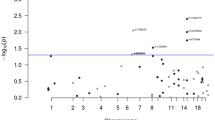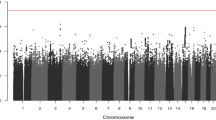Abstract
Recently, homozygosity for T91A single-nucleotide polymorphism (SNP) in the serine/threonine kinase (STK15) gene, which generates the substitution F31I has been proposed to increase the risk of a number of tumours including colorectal cancer (CRC). To further evaluate the relationship between STK15 F31I and risk of CRC, we genotyped 2558 CRC cases and 2680 controls for this polymorphism. We found no evidence that homozygosity for the STK15 31I genotype confers an increased risk of CRC (odds ratio=0.95, 95% confidence interval (CI): 0.74–1.24). We also conducted a kin-cohort analysis to assess risk among first-degree relatives of the CRC cases. The hazard ratio for I/I homozygotes compared to F/F homozygotes was 1.65 (95% CI: 0.39–3.17). A meta-analysis of our case–control data and three previous studies also provided no evidence of an elevated risk of CRC associated with homozygosity. These data provide no support for the hypothesis that sequence variation in STK15 defined by SNP F31I per se confers an elevated risk of CRC.
Similar content being viewed by others
Main
Serine/threonine kinase (STK15; MIM:603072) is a regulator of mitotic chromosomal segregation (Dutertre et al, 2002) and plays a role in the development of malignancy (Bischoff et al, 1998; Zhou et al, 1998; Ewart-Toland et al, 2003). Recently, the T91A single-nucleotide polymorphism (SNP) in STK15, which generates the substitution F31I, and has been reported to influence genomic instability (Ewart-Toland et al, 2003; Kimura et al, 2005), has been proposed as a low penetrance variant for a number of tumours including colorectal cancer (CRC) (Ewart-Toland et al, 2003, 2005). To further evaluate the relationship between STK15 F31I and risk of CRC, we genotyped 2558 CRC cases and 2680 controls for this polymorphism. We also conducted a kin-cohort analysis to assess risk among first-degree relatives of the CRC cases.
Materials and methods
Unselected CRC cases with histologically confirmed colorectal adenocarcinomas (1471 men; 1087 women; mean age at diagnosis 61 years; standard deviation (s.d.)±11.4) were ascertained through over 100 centres in the UK. Detailed family histories were obtained from cases by previously validated questionnaire. Controls (836 men; 1844 women; mean age 59 years; s.d.±10.9) were the spouses or friends of patients with malignancies ascertained as part of ongoing National Cancer Research Network genetic epidemiological studies (1999–2004; n=1067), the Royal Marsden Hospital Trust/Institute of Cancer Research Family History and DNA Registry (1999–2004; n=1021) and UK Study of Breast Cancer Genetics (1999–2004; n=592) all established within the UK. None of the controls had a personal history of malignancy at time of ascertainment. As we are not seeking to evaluate environmental interactive effects, the theoretical possibility of ‘overmatching’ on environmental factors by using spouse and friend controls is unlikely to impact on study findings. All cases and controls were British Caucasians, and there were no obvious differences in the demography of cases and controls in terms of place of residence within the UK. Blood samples were obtained with informed consent and ethical review board approval in accordance with the tenets of the Declaration of Helsinki.
Analysis of STK15 F31I was undertaken as part of our ongoing analyses to identify low penetrance alleles based on the National Study of Colorectal Cancer Genetics Trial (2004). DNA was extracted from blood samples using conventional methodologies and quantified using PicoGreen (Invitrogen, Carlsbad, CA, USA). Genotyping was performed using the Illumina Sentrix Bead Array system according to the manufacturer's protocols. Further information on the assays is available on request.
Risks were estimated by odds ratios (ORs) using unconditional logistic regression, and associated 95% confidence intervals (CIs) computed. Meta-analysis of this and other published studies was conducted using standard methods for combining estimates of ORs based on the weighted sum of the log estimates with the inverse of the variance of the estimate of the weight. Cochran's Q statistic (Cochran, 1954) to test for heterogeneity and the I2 statistic (Higgins et al, 2003) to quantify the proportion of the total variation owing to heterogeneity were calculated. To incorporate within-study and between-study variability, we used DerSimioian and Laird's method (DerSimonian and Laird, 1986) for calculating random effects summary ORs and their associated 95% CIs. All computations were undertaken in STATA (version 8.2, Stata Corporation, College Station, TX, USA).
We also performed a kin-cohort analysis to compare the CRC risk in first-degree relatives of STK15 I homozygotes with that in first-degree relatives of F homozygotes. Proband genotypes and the SNP allele frequency were used to infer genotypes of relatives. Age-specific cumulative CRC distributions in first-degree relatives were estimated using a marginal likelihood approach (Chatterjee and Wacholder, 2001), implemented in MatLab version 7.0.1 (MathWorks, Natick, MA, USA). Bootstrap estimates for the hazard ratio (HR) were then computed, using 1000 resamples of the data, and used to generate a 95% CI.
Results
There was no evidence of population stratification as the genotype distribution of F31I in controls satisfied Hardy–Weinberg equilibrium (P=0.63). We found no evidence that homozygosity for the STK15 I genotype confers an increased risk of CRC (cases: F/F=1564, F/I=880 and I/I=114; controls: F/F=1667, F/I=888, I/I=125; OR=0.95, 95% CI: 0.74–1.24). As there is no a priori reason to assume a recessive model of CRC susceptibility, we also computed the risk associated with heterozygotes using the F/F genotype as the reference group. The OR under this model was 1.06 (95% CI: 0.94–1.19).
Three other studies have compared the frequency of STK15 F31I genotypes in cases and controls (Ewart-Toland et al, 2005); two based on predominantly Caucasians and one based on Han Chinese. Figure 1 shows estimates of the recessive homozygote risk from this study and from published studies. The study based on Han Chinese was alone in showing a significant positive association and was the only study where results differed significantly from our analysis. The pooled OR estimate was 1.31 (95% CI: 0.96–1.78); interpretation of this is not, however, clear as the estimates in different studies are clearly heterogeneous (Cochran's Q=8.21, P=0.042, I2=64%). Restricting the meta-analysis to the three studies based on Caucasians, between-study heterogeneity was less evident (Cochran's Q=3.1, P=0.21, I2=35%). The pooled estimate of the OR was 1.15 (95% CI: 0.87–1.51).
Forest plot of the risk of CRC associated with STK15-I/I homozygosity from comparison of I/I vs I/F and F/F genotypes combined for (A) all studies and (B) all Caucasian studies. Shaded squares denote ORs, with their size being proportional to the inverse variance of the study-specific estimate. Horizontal lines represent 95% CIs. The diamond denotes the combined random effects estimate and its associated 95% CI. The vertical line indicates the null effect (OR=1.0).
The 2558 cases reported a total of 14 649 first-degree relatives of whom 445 (3.0%) had been diagnosed with CRC. The HR for I/I homozygotes compared to F/F homozygotes was 1.65 (95% CI: 0.39–3.17).
Discussion
It has previously been proposed that the STK15 F31I polymorphism confers a 1.5-fold increase in risk of CRC (Ewart-Toland et al, 2005). Even though our study had over 90% power to detect this magnitude of increased risk at significance level 5%, we found no evidence to support the hypothesis that F31I is a CRC susceptibility allele. Moreover, the meta-analysis we conducted of 9309 subjects also provides no evidence of an increased risk. There was, however, a high degree of variation in the ORs estimated by individual studies. The frequency of the I-allele is markedly different in Caucasians and Han Chinese (21 and 61% respectively), thus it may be inappropriate to regard the different ethnic groups as genetically similar. As the frequency of genotypes in controls in the other studies are not significantly different from those expected, there is little evidence that overt population stratification underpins study heterogeneity. Although there is some data to suggest that F31I has functional cellular consequences (Ewart-Toland et al, 2003; Kimura et al, 2005), direct causality has not been demonstrated. It is possible that population-specific linkage disequilibrium with another functional variant could be operating. Some support for this is provided by the observation of Lo et al (2005) that in the Taiwanese population the risk of breast cancer associated with F31I is mediated through an extended haplotype. Finally, as with all association studies a simple but unattractive explanation for the observed heterogeneity is publication bias. In summary, collectively these data provide no support for the hypothesis that sequence variation in STK15 defined by the nonsynonymous SNP F31I per se confers an elevated risk of CRC.
Change history
16 November 2011
This paper was modified 12 months after initial publication to switch to Creative Commons licence terms, as noted at publication
References
Bischoff JR, Anderson L, Zhu Y, Mossie K, Ng L, Souza B, Schryver B, Flanagan P, Clairvoyant F, Ginther C, Chan CS, Novotny M, Slamon DJ, Plowman GD (1998) A homologue of Drosophila aurora kinase is oncogenic and amplified in human colorectal cancers. EMBO J 17: 3052–3065
Chatterjee N, Wacholder S (2001) A marginal likelihood approach for estimating penetrance from kin-cohort designs. Biometrics 57: 245–252
Cochran W (1954) The contribution of estimates from different experiments. Biometrics 10: 101–129
DerSimonian R, Laird N (1986) Meta-analysis in clinical trials. Control Clin Trials 7: 177–188
Dutertre S, Descamps S, Prigent C (2002) On the role of aurora-A in centrosome function. Oncogene 21: 6175–6183
Ewart-Toland A, Briassouli P, de Koning JP, Mao JH, Yuan J, Chan F, MacCarthy-Morrogh L, Ponder BA, Nagase H, Burn J, Ball S, Almeida M, Linardopoulos S, Balmain A (2003) Identification of Stk6/STK15 as a candidate low-penetrance tumor-susceptibility gene in mouse and human. Nat Genet 34: 403–412
Ewart-Toland A, Dai Q, Gao YT, Nagase H, Dunlop MG, Farrington SM, Barnetson RA, Anton-Culver H, Peel D, Ziogas A, Lin D, Miao X, Sun T, Ostrander EA, Stanford JL, Langlois M, Chan JM, Yuan J, Harris CC, Bowman ED, Clayman GL, Lippman SM, Lee JJ, Zheng W, Balmain A (2005) Aurora-A/STK15 T+91A is a general low penetrance cancer susceptibility gene: a meta-analysis of multiple cancer types. Carcinogenesis 26: 1368–1373
Higgins JP, Thompson SG, Deeks JJ, Altman DG (2003) Measuring inconsistency in meta-analyses. BMJ 327: 557–560
Kimura MT, Mori T, Conroy J, Nowak NJ, Satomi S, Tamai K, Nagase H (2005) Two functional coding single nucleotide polymorphisms in STK15 (Aurora-A) coordinately increase esophageal cancer risk. Cancer Res 65: 3548–3554
Lo YL, Yu JC, Chen ST, Yang HC, Fann CS, Mau YC, Shen CY (2005) Breast cancer risk associated with genotypic polymorphism of the mitosis-regulating gene Aurora-A/STK15/BTAK. Int J Cancer 115: 276–283
Zhou H, Kuang J, Zhong L, Kuo WL, Gray JW, Sahin A, Brinkley BR, Sen S (1998) Tumour amplified kinase STK15/BTAK induces centrosome amplification, aneuploidy and transformation. Nat Genet 20: 189–193
Acknowledgements
We thank all subjects for their participation. Funding for this work was undertaken with support from Cancer Research UK.
Author information
Authors and Affiliations
Corresponding author
Rights and permissions
From twelve months after its original publication, this work is licensed under the Creative Commons Attribution-NonCommercial-Share Alike 3.0 Unported License. To view a copy of this license, visit http://creativecommons.org/licenses/by-nc-sa/3.0/
About this article
Cite this article
Webb, E., Rudd, M. & Houlston, R. Case–control, kin-cohort and meta-analyses provide no support for STK15 F31I as a low penetrance colorectal cancer allele. Br J Cancer 95, 1047–1049 (2006). https://doi.org/10.1038/sj.bjc.6603382
Received:
Revised:
Accepted:
Published:
Issue Date:
DOI: https://doi.org/10.1038/sj.bjc.6603382
Keywords
This article is cited by
-
Breast Cancer Risk Associated with Genotype Polymorphisms of the Aurora Kinase a Gene (AURKA): a Case-Control Study in a High Altitude Ecuadorian Mestizo Population
Pathology & Oncology Research (2018)
-
Association between the STK15 polymorphisms and risk of cancer: a meta-analysis
Molecular Genetics and Genomics (2015)
-
Common genetic polymorphisms of AURKA and prostate cancer risk
Cancer Causes & Control (2009)
-
National study of colorectal cancer genetics
British Journal of Cancer (2007)




